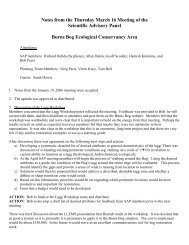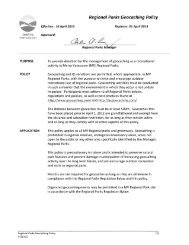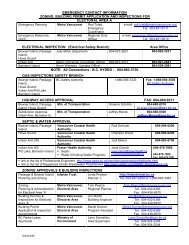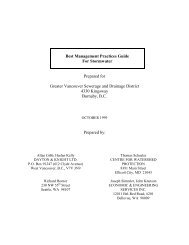Chlorine Monitoring and Dechlorination Techniques Handbook
Chlorine Monitoring and Dechlorination Techniques Handbook
Chlorine Monitoring and Dechlorination Techniques Handbook
Create successful ePaper yourself
Turn your PDF publications into a flip-book with our unique Google optimized e-Paper software.
<strong>Chlorine</strong> <strong>Monitoring</strong> <strong>and</strong> Dechlorinating <strong>Techniques</strong> H<strong>and</strong>book<br />
a creek or lake, an environmental impact can result because of a reduction in the oxygen<br />
content of the water. Care must be taken to ensure that oxygen levels are not significantly<br />
altered with the addition of such chemicals. The best way to ensure that oxygen is not<br />
depleted is to use sodium thiosulphate as the dechlorinating agent rather than sodium sulphite<br />
or sodium bisulfite.<br />
pH Levels<br />
Although not specifically related to dechlorination it should be noted that chlorine solutions<br />
(eg. sodium hypochlorite) used to super chlorinate water mains have a very high pH level to<br />
ensure that chlorine gas does not form in the solution. Adding sodium hypochlorite to water<br />
having a low buffering capacity, such as is the case with the GVRD water supply, could<br />
cause elevated pH levels. In addition to dechlorinating this disinfection water prior to<br />
discharge, the pH level should be determined prior to discharge of this water <strong>and</strong>, if<br />
necessary, measures taken to adjust the pH to appropriate levels. The optimum pH range is<br />
6.5 to 9.0 as per the BC Environment Approved <strong>and</strong> Working Water Quality Criteria (1996).<br />
If the pH requires adjusting, it can be adjusted using a tank of carbon dioxide bubbled into<br />
the water to reduce a high (basic) pH or by adding sodium bicarbonate to a low (acidic) pH.<br />
1.5 When to Dechlorinate<br />
In order to assess whether dechlorination is necessary during or after a water release, the<br />
following conditions should be considered:<br />
(1) the volume of chlorinated water being discharged;<br />
(2) the concentration of total residual chlorine in the water;<br />
(3) the proximity of the point of discharge to a natural aquatic system; <strong>and</strong><br />
(4) the volume or flow of the receiving environment available to dilute the<br />
release.<br />
For instance, using a garden hose to wash down a truck would not generate sufficient water<br />
to warrant dechlorination. However, creeks should be protected from detergent or silt<br />
releases. Similarly, if there are no natural aquatic systems within several kilometres of the<br />
point of discharge, <strong>and</strong> the volume of water released is low, then the need for dechlorination<br />
techniques would be diminished. In other cases, though, dechlorination would be m<strong>and</strong>atory.<br />
For example, flushing an 8" water main can generate 780 gallons of water per minute <strong>and</strong><br />
higher. This flow exceeds the flow of many small creeks <strong>and</strong> could cause significant impact<br />
if water is discharged directly to a creek without removal of chlorine residuals.<br />
<strong>Dechlorination</strong> is required when the combination of the volume of municipal water being<br />
released, the concentration of total residual chlorine, <strong>and</strong> the proximity of the site to a natural<br />
aquatic system indicates a potential risk to the environment. The type of water releases that<br />
Page 4

















